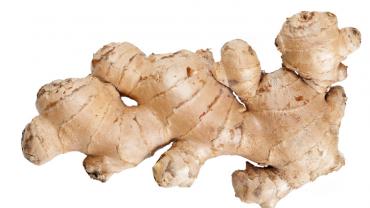
Ginger rhizome (Zingiber officinale) and its extracts have been used as a culinary food and spice and in traditional medicines for more than 3,000 years due to its nutrients and targeted medicinal activity. According to epidemiological studies, ginger and ginger extracts have shown the ability to impart beneficial effects on metabolism, blood sugar, inflammation, and lipid metabolism and cholesterol.
Zingiber officinale contains potent biologically active constituents, such as terpenes, phenolics (e.g., gingerols), and estrogens, that are involved in immunology and inflammation, in addition to many other activities. These bioactives exert their effects through various cell signaling pathways, such as mitogen-activated protein kinase, mammalian target of rapamycin/protein kinase B/phosphoinositide 3-kinase, 5' adenosine monophosphate-activated protein kinase, and insulin-like growth factor-1 involved in autophagy, development and differentiation, and cellular metabolism, among other cell functions. These constituents were shown to be associated with antioxidant, anti-inflammatory, analgesic, and antimicrobial activity, and they have gastroprotective, chemoprotective, and other beneficial effects.
Clinical studies have discovered various mechanisms by which 6-, 8-, and 10-gingerol moieties impart anti-inflammatory actions, providing the basis for the therapeutic applications of ginger. These gingerols inhibited sensitized T- and B-lymphocytes and T-lymphocyte proliferation in autoimmune diseases. In type 2 diabetes, 6-gingerol was shown to suppress interleukin (IL)-1B-induced liver cell inflammatory response and suppress ischemia- and reperfusion-induced inflammatory damage in the heart and intestines. Likewise, these bioactive constituents blocked TLR4 activation, which is a key signaling pathway in cancer progression and the inflammatory response.
Gingerols have also been shown to help support a healthy inflammatory response in joints in those with rheumatoid arthritis (RA). In a randomized controlled trial of 70 patients with RA, participants received 1,500 mg per day of ginger powder for 12 weeks. These patients were found to have significantly reduced RA symptoms and disease manifestations by inducing FOXP3 gene expression and decreasing T-bet and ROR-γt gene expression.
In a meta-analysis of eight trials with 734 participants, ginger extracts significantly decreased pain sensitivity and indicated a better safety profile compared to commonly used anti-inflammatory drugs for the management of chronic pain. Another meta-analysis of randomized controlled trials reported ginger to significantly reduce pain and disability in patients with osteoarthritis (OA) compared to a placebo. With 500 mg of ginger powder supplementation per day for 3 months, OA patients were found to have reduced pro-inflammatory cytokine levels.
Furthermore, patients with acute respiratory distress syndrome (ARDS) and asthma experienced improvements in asthmatic symptoms, reduced length of stay in the intensive care unit, and reduced duration of mechanical ventilation due to significantly lower levels of serum IL-1, IL-6, and tumor necrosis factor-alpha, and increased glutathione levels compared with the control group. In human airway smooth muscle cells, ginger and its bioactive components demonstrated relaxant properties and attenuated airways hyper-responsiveness by inducing bronchodilation and modulating intracellular calcium ion activity. The researchers suggest ginger may be a safe targeted option to support the treatment of airway diseases such as ARDS and asthma.
By Caitlin Higgins, MSCN, CNS